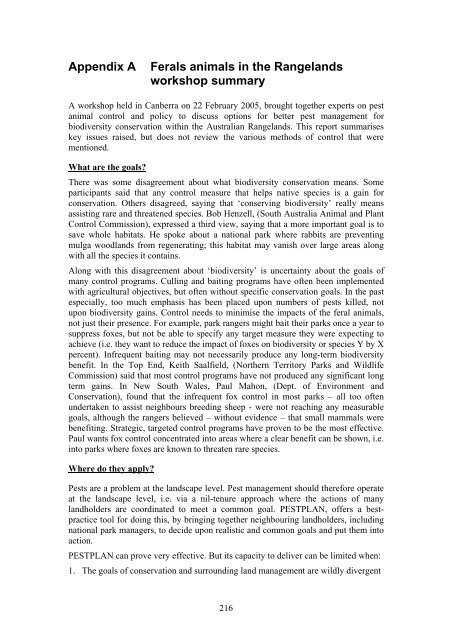Review of the management of feral animals and their impact on ...
Review of the management of feral animals and their impact on ...
Review of the management of feral animals and their impact on ...
Create successful ePaper yourself
Turn your PDF publications into a flip-book with our unique Google optimized e-Paper software.
Appendix A Ferals <str<strong>on</strong>g>animals</str<strong>on</strong>g> in <str<strong>on</strong>g>the</str<strong>on</strong>g> Rangel<str<strong>on</strong>g>and</str<strong>on</strong>g>s<br />
workshop summary<br />
A workshop held in Canberra <strong>on</strong> 22 February 2005, brought toge<str<strong>on</strong>g>the</str<strong>on</strong>g>r experts <strong>on</strong> pest<br />
animal c<strong>on</strong>trol <str<strong>on</strong>g>and</str<strong>on</strong>g> policy to discuss opti<strong>on</strong>s for better pest <str<strong>on</strong>g>management</str<strong>on</strong>g> for<br />
biodiversity c<strong>on</strong>servati<strong>on</strong> within <str<strong>on</strong>g>the</str<strong>on</strong>g> Australian Rangel<str<strong>on</strong>g>and</str<strong>on</strong>g>s. This report summarises<br />
key issues raised, but does not review <str<strong>on</strong>g>the</str<strong>on</strong>g> various methods <str<strong>on</strong>g>of</str<strong>on</strong>g> c<strong>on</strong>trol that were<br />
menti<strong>on</strong>ed.<br />
What are <str<strong>on</strong>g>the</str<strong>on</strong>g> goals?<br />
There was some disagreement about what biodiversity c<strong>on</strong>servati<strong>on</strong> means. Some<br />
participants said that any c<strong>on</strong>trol measure that helps native species is a gain for<br />
c<strong>on</strong>servati<strong>on</strong>. O<str<strong>on</strong>g>the</str<strong>on</strong>g>rs disagreed, saying that ‘c<strong>on</strong>serving biodiversity’ really means<br />
assisting rare <str<strong>on</strong>g>and</str<strong>on</strong>g> threatened species. Bob Henzell, (South Australia Animal <str<strong>on</strong>g>and</str<strong>on</strong>g> Plant<br />
C<strong>on</strong>trol Commissi<strong>on</strong>), expressed a third view, saying that a more important goal is to<br />
save whole habitats. He spoke about a nati<strong>on</strong>al park where rabbits are preventing<br />
mulga woodl<str<strong>on</strong>g>and</str<strong>on</strong>g>s from regenerating; this habitat may vanish over large areas al<strong>on</strong>g<br />
with all <str<strong>on</strong>g>the</str<strong>on</strong>g> species it c<strong>on</strong>tains.<br />
Al<strong>on</strong>g with this disagreement about ‘biodiversity’ is uncertainty about <str<strong>on</strong>g>the</str<strong>on</strong>g> goals <str<strong>on</strong>g>of</str<strong>on</strong>g><br />
many c<strong>on</strong>trol programs. Culling <str<strong>on</strong>g>and</str<strong>on</strong>g> baiting programs have <str<strong>on</strong>g>of</str<strong>on</strong>g>ten been implemented<br />
with agricultural objectives, but <str<strong>on</strong>g>of</str<strong>on</strong>g>ten without specific c<strong>on</strong>servati<strong>on</strong> goals. In <str<strong>on</strong>g>the</str<strong>on</strong>g> past<br />
especially, too much emphasis has been placed up<strong>on</strong> numbers <str<strong>on</strong>g>of</str<strong>on</strong>g> pests killed, not<br />
up<strong>on</strong> biodiversity gains. C<strong>on</strong>trol needs to minimise <str<strong>on</strong>g>the</str<strong>on</strong>g> <str<strong>on</strong>g>impact</str<strong>on</strong>g>s <str<strong>on</strong>g>of</str<strong>on</strong>g> <str<strong>on</strong>g>the</str<strong>on</strong>g> <str<strong>on</strong>g>feral</str<strong>on</strong>g> <str<strong>on</strong>g>animals</str<strong>on</strong>g>,<br />
not just <str<strong>on</strong>g>the</str<strong>on</strong>g>ir presence. For example, park rangers might bait <str<strong>on</strong>g>the</str<strong>on</strong>g>ir parks <strong>on</strong>ce a year to<br />
suppress foxes, but not be able to specify any target measure <str<strong>on</strong>g>the</str<strong>on</strong>g>y were expecting to<br />
achieve (i.e. <str<strong>on</strong>g>the</str<strong>on</strong>g>y want to reduce <str<strong>on</strong>g>the</str<strong>on</strong>g> <str<strong>on</strong>g>impact</str<strong>on</strong>g> <str<strong>on</strong>g>of</str<strong>on</strong>g> foxes <strong>on</strong> biodiversity or species Y by X<br />
percent). Infrequent baiting may not necessarily produce any l<strong>on</strong>g-term biodiversity<br />
benefit. In <str<strong>on</strong>g>the</str<strong>on</strong>g> Top End, Keith Saalfield, (Nor<str<strong>on</strong>g>the</str<strong>on</strong>g>rn Territory Parks <str<strong>on</strong>g>and</str<strong>on</strong>g> Wildlife<br />
Commissi<strong>on</strong>) said that most c<strong>on</strong>trol programs have not produced any significant l<strong>on</strong>g<br />
term gains. In New South Wales, Paul Mah<strong>on</strong>, (Dept. <str<strong>on</strong>g>of</str<strong>on</strong>g> Envir<strong>on</strong>ment <str<strong>on</strong>g>and</str<strong>on</strong>g><br />
C<strong>on</strong>servati<strong>on</strong>), found that <str<strong>on</strong>g>the</str<strong>on</strong>g> infrequent fox c<strong>on</strong>trol in most parks – all too <str<strong>on</strong>g>of</str<strong>on</strong>g>ten<br />
undertaken to assist neighbours breeding sheep - were not reaching any measurable<br />
goals, although <str<strong>on</strong>g>the</str<strong>on</strong>g> rangers believed – without evidence – that small mammals were<br />
benefiting. Strategic, targeted c<strong>on</strong>trol programs have proven to be <str<strong>on</strong>g>the</str<strong>on</strong>g> most effective.<br />
Paul wants fox c<strong>on</strong>trol c<strong>on</strong>centrated into areas where a clear benefit can be shown, i.e.<br />
into parks where foxes are known to threaten rare species.<br />
Where do <str<strong>on</strong>g>the</str<strong>on</strong>g>y apply?<br />
Pests are a problem at <str<strong>on</strong>g>the</str<strong>on</strong>g> l<str<strong>on</strong>g>and</str<strong>on</strong>g>scape level. Pest <str<strong>on</strong>g>management</str<strong>on</strong>g> should <str<strong>on</strong>g>the</str<strong>on</strong>g>refore operate<br />
at <str<strong>on</strong>g>the</str<strong>on</strong>g> l<str<strong>on</strong>g>and</str<strong>on</strong>g>scape level, i.e. via a nil-tenure approach where <str<strong>on</strong>g>the</str<strong>on</strong>g> acti<strong>on</strong>s <str<strong>on</strong>g>of</str<strong>on</strong>g> many<br />
l<str<strong>on</strong>g>and</str<strong>on</strong>g>holders are coordinated to meet a comm<strong>on</strong> goal. PESTPLAN, <str<strong>on</strong>g>of</str<strong>on</strong>g>fers a bestpractice<br />
tool for doing this, by bringing toge<str<strong>on</strong>g>the</str<strong>on</strong>g>r neighbouring l<str<strong>on</strong>g>and</str<strong>on</strong>g>holders, including<br />
nati<strong>on</strong>al park managers, to decide up<strong>on</strong> realistic <str<strong>on</strong>g>and</str<strong>on</strong>g> comm<strong>on</strong> goals <str<strong>on</strong>g>and</str<strong>on</strong>g> put <str<strong>on</strong>g>the</str<strong>on</strong>g>m into<br />
acti<strong>on</strong>.<br />
PESTPLAN can prove very effective. But its capacity to deliver can be limited when:<br />
1. The goals <str<strong>on</strong>g>of</str<strong>on</strong>g> c<strong>on</strong>servati<strong>on</strong> <str<strong>on</strong>g>and</str<strong>on</strong>g> surrounding l<str<strong>on</strong>g>and</str<strong>on</strong>g> <str<strong>on</strong>g>management</str<strong>on</strong>g> are wildly divergent<br />
216
















